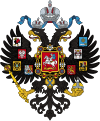Elizabeth of Russia
Elizabeth Petrovna (Russian: Елизаве́та (Елисаве́та) Петро́вна) (29 December [O.S. 18 December] 1709 – 5 January 1762 [O.S. 25 December 1761]), also known as Yelisaveta or Elizaveta, was the Empress of Russia from 1741 until her death in 1762. She led the country during the two major European conflicts of her time: the War of Austrian Succession (1740–48) and the Seven Years' War (1756–63).
| Elizabeth | |
|---|---|
| Empress and Autocrat of All Russia | |
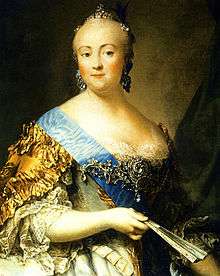 Portrait painted by Vigilius Eriksen in 1757 | |
| Empress of Russia | |
| Reign | 6 December 1741 – 5 January 1762 |
| Coronation | 6 May 1742 |
| Predecessor | Ivan VI |
| Successor | Peter III |
| Born | 29 December 1709 Kolomenskoye, Moscow, Tsardom of Russia |
| Died | 5 January 1762 (aged 52) Winter Palace, Saint Petersburg, Russian Empire |
| Burial | 3 February 1762 (O.S.) Peter and Paul Cathedral |
| House | Romanov |
| Father | Peter I of Russia |
| Mother | Catherine I of Russia |
| Religion | Russian Orthodoxy |
| Signature |  |
Her domestic policies allowed the nobles to gain dominance in local government while shortening their terms of service to the state. She encouraged Mikhail Lomonosov's establishment of the University of Moscow and Ivan Shuvalov's foundation of the Imperial Academy of Arts in Saint Petersburg. She also spent exorbitant sums of money on the grandiose baroque projects of her favourite architect, Bartolomeo Rastrelli, particularly in Peterhof and Tsarskoye Selo. The Winter Palace and the Smolny Cathedral in Saint Petersburg are among the chief monuments of her reign. She remains one of the most popular Russian monarchs due to her strong opposition to Prussian policies and her decision not to execute a single person during her reign.[1]
Early life
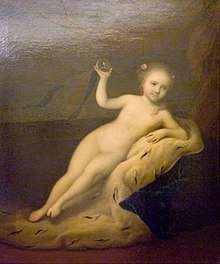
Elizabeth was born at Kolomenskoye, near Moscow, on 18 December 1709 (O.S.), the daughter of Peter the Great, Tsar of Russia, by his second wife, Catherine I.[2] Catherine was the daughter of Samuel Skowroński, a Latvian peasant of Polish origin. Although no documentary record exists, they are said to have married secretly at the Cathedral of the Holy Trinity in St. Petersburg at some point between 23 October and 1 December 1707.[3] Peter valued Catherine and married her again (this time officially) at Saint Isaac's Cathedral in St. Petersburg on 9 February 1712. On this day, the two children previously born to them (Anna and Elizabeth) were legitimized by their father.[3] The circumstances of Elizabeth's birth would later be used by her political opponents to challenge her right to the throne on grounds of illegitimate birth.
Of the twelve children born to Peter and Catherine (five sons and seven daughters), only two daughters, Anna (born 1708) and Elizabeth (born 1709), survived to adulthood.[4] Both of them were given the title of Tsarevna ("princess") on 6 March 1711, and of Tsesarevna ("crown princess") on 23 December 1721.[2] They had one older surviving sibling, crown prince Alexei Petrovich, who was Peter's son by his first wife Eudoxia Lopukhina, a noblewoman.
As a child, Elizabeth was the particular favorite of her father. She resembled him both physically and temperamentally.[5] She was a bright girl, if not brilliant, but received only a desultory formal education.[6] Even though he adored his daughter, Peter did not devote time or attention to her education. He had a son (and grandson) from his first marriage to a noblewoman, and did not anticipate that a daughter born to his former maid and second wife might one day inherit the throne. Indeed, no woman had ever sat upon the throne of Russia. It was therefore left to Catherine to raise the girls as best she could, but she was herself too uneducated to be able to superintend the formal education of her daughters. Elizabeth had a French governess and grew fluent in Italian, German and French. She was also an excellent dancer and rider.[2] Like her father, Elizabeth was physically active and loved riding, hunting, sledging, skating, and gardening.[7] From her earliest years, she delighted everyone with her extraordinary beauty and vivacity, and was regarded as the leading beauty of the Russian Empire.[2] The wife of the British minister (ambassador) described Elizabeth as "fair, with light brown hair, large sprightly blue eyes, fine teeth and a pretty mouth. She is inclinable to be fat, but is very genteel and dances better than anyone I ever saw. She speaks German, French and Italian, is extremely gay and talks to everyone..."[8]
Marriage plans and personal life
.jpg)
Peter was enamored of western Europe, and much of his fame rests on his efforts to westernize Russia. A corollary to this proclivity was his desire to see his children married into the royal houses of Europe, something which his predecessors had consciously avoided. Peter's only son and heir was born of his first marriage to a nobleman's daughter, and no problem was encountered in securing a bride for him, Charlotte Christine of Brunswick-Luneburg, from the ancient house of Brunswick-Lüneburg. However, Peter was hard put to arrange similar marriages for the daughters born of his second wife. He was roundly snubbed by the Bourbons of France when, during a visit to that country, he offered either of his daughters in marriage to the future Louis XV. The French court conveyed to him in essence that the circumstance of their post-facto legitimization, made the girls unacceptable.[4] The young French king Louis XV would later end up marrying the Polish noblewoman Marie Leszczyńska, daughter of the briefly-reigning King Stanisław Leszczyński of Poland, who was looked down by almost all of Europe as of insufficient rank to be Queen of France but politically suitable for the French ministers, much to the chagrin of the later Empress Elizabeth.
In 1724, Peter betrothed his daughters to two young princes, first cousins to each other, who hailed from the tiny north German principality of Holstein-Gottorp, and whose family was undergoing a period of political and economic stress. Anna Petrovna (aged 16) was to marry Charles Frederick, Duke of Holstein-Gottorp, who was then living in exile in Russia as Peter's guest after having failed in his attempt to succeed his maternal uncle as King of Sweden, and whose patrimony (Holstein-Gottorp) was at that time under Danish occupation.[4] Despite all this, the prince was of impeccable birth and well-connected to many royal houses; it was a respectable and politically useful alliance,[9] and Peter was happy. Some time later, and in the same year, Elizabeth was betrothed to marry Charles Frederick's first cousin, Charles Augustus of Holstein-Gottorp,[9] the eldest son of Christian Augustus, Prince of Eutin. Anna's wedding was held in 1725 as planned, even though her father, Peter the Great, died a few weeks before the nuptials. In Elizabeth's case, however, her fiancé died on 31 May 1727, before the wedding could be celebrated. This came as a double blow to Elizabeth, because her mother Catherine I (who had succeeded Peter the Great to the throne) had died just two weeks previously, on 17 May 1727.
Thus, by the end of May 1727, Elizabeth, at 17 years of age, had lost her fiancé and both of her parents; and furthermore, her half-nephew Peter II was on the throne. Her marriage prospects immediately dried up. They did not improve when, three years later, Peter II died and was succeeded by Elizabeth's first cousin, Empress Anna (ruled 1730–40), daughter of Peter the Great's elder brother Ivan V. There was little love lost between the cousins and no prospect of either any Russian nobleman or any foreign prince seeking Elizabeth's hand in marriage. Nor could Elizabeth marry a commoner because it would cost her not only her title and royal status, but also her property rights and her claim to the throne.[10] The fact that Elizabeth was something of a beauty did not bring her any advantage in marriage prospects; on the other hand, it earned her some resentment. When the Chinese minister in St. Petersburg was asked by the Empress Anna who was the most beautiful woman at her court, he pointed to Elizabeth, to Anna's intense displeasure.[11]
Elizabeth's response to the lack of marriage prospects was to take Alexis Shubin, a handsome sergeant in the Semyonovsky Guards regiment, as her lover.[10] When Empress Anna found out about this, she had Shubin's tongue cut off and banished him to Siberia. Elizabeth consoled herself with a handsome coachman and then turned to a footman for her sexual pleasure.[10] Eventually she found her long-term companion in Alexis Razumovsky, a young and handsome Ukrainian peasant serf with a good bass voice. Razumovsky had been brought from his village to St. Petersburg by his master, a nobleman, to sing for a church choir. Elizabeth purchased the talented serf from the nobleman for her own choir. Razumovsky, a good-hearted and simple-minded man, never evidenced any personal ambition or interest in affairs of state during all the years of his relationship with Elizabeth, which spanned from the days of her obscurity to the height of her power as Empress. In turn, Elizabeth was devoted to Razumovsky, and there is reason to believe that she might even have married him in a secret ceremony. Razumovsky would later become known as "the Emperor of the Night." In 1742, the Holy Roman Emperor made Razumovsky a Count of the Holy Roman Empire, and in 1756, Elizabeth made him a Prince and a Field Marshal.[10]
Years of obscurity
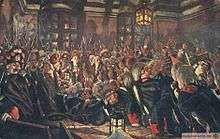
So long as Aleksandr Danilovich Menshikov remained in power (until September 1727) the government of Elizabeth's adolescent half-nephew Peter II (reigned 1727–1730) treated her with liberality and distinction. The Dolgorukovs, an ancient boyar family, deeply resented Menshikov.[12] With Peter II's attachment to Prince Ivan Dolgorukov, and with two of their family members on the Supreme State Council, they had the leverage for a successful coup. Menshikov was arrested, stripped of all his honours and properties and exiled to northern Siberia where he died in November 1729.[12] The Dolgorukovs hated the memory of Peter the Great and practically banished his daughter from Court.[13]
During the reign of her cousin, Anna (1730–1740), Elizabeth was gathering support in the background. After the death of Empress Anna, the regency of Anna Leopoldovna for the infant Ivan VI was marked by high taxes and economic problems. Elizabeth, being the daughter of Peter the Great, enjoyed much support from the Russian guards regiments.[1] The French ambassador in St. Petersburg, the marquis de La Chétardie was deeply involved in planning a coup to depose the regent Anna whose anti-French foreign policy was opposed to the interests of France, and bribed numerous officers in the Imperial Guard to support the coup.[14]
French adventurer Count Lestocq shaped Elizabeth's actions according to the advice of the marquis de La Chétardie and the Swedish ambassador, who were particularly interested in toppling the regime of Anna Leopoldovna, as France sought to counterbalance the Austrian influence at the Russian court and Sweden waged a war against Russia at that time.
Coup and early rule
Elizabeth often visited the elite Guards regiments, marking special events with the officers, and acting as godmother to their children.[1] The guards repaid her kindness when, on the night of 25 November 1741 (O.S.), Elizabeth seized power with the help of the Preobrazhensky Regiment. Arriving at the regimental headquarters wearing a warrior's metal breastplate over her dress and grasping a silver cross she challenged them: "Whom do you want to serve: me, your natural sovereign, or those who have stolen my inheritance?" Won over, the regiment marched to the Winter Palace and arrested the infant Emperor, his parents, and their own lieutenant-colonel, Count von Munnich. It was a daring coup and, amazingly, succeeded without bloodshed. Elizabeth had vowed that if she became Empress she would not sign a single death sentence, an extraordinary promise for the time but one which she kept throughout her life,[1] although there was still cruelty in her regime—as the case of the courtier Natalia Lopukhina, who was publicly flogged and mutilated, attests.[15]
A conspiracy in the early days of her rule threatened her source of power. When Count Ivan Lopukhin complained of Empress Elizabeth in a tavern, he was overheard and tortured for information. He implicated his mother, Countess Natalia Lopukhina, as well as himself and others, in a plot to reinstate Ivan VI as tsar. They were all sentenced to death, but Elizabeth pardoned a few of the women. Instead they would have their tongues removed, and would be publicly flogged.[16]
Although at first Elizabeth had thought to allow the young tsar and his mother to leave Russia, she imprisoned them later in a Shlisselburg Fortress, clearly having changed her mind. She worried that they would stir up trouble for her in other parts of Europe, and she had no wish to risk that.[17]
Domestic policy
.jpg)
At the age of thirty-three, with relatively little political experience, Elizabeth found herself at the head of a great empire at one of the most critical periods of its existence. Her proclamation as Empress Elizabeth I explained that the preceding reigns had led Russia to ruin: "The Russian people have been groaning under the enemies of the Christian faith, but she has delivered them from the degrading foreign oppression."[18] Russia had been under the domination of German advisers, and Elizabeth exiled the most unpopular of them, including Heinrich Ostermann, Burkhard von Munnich and Carl Gustav Lowenwolde.[18] Elizabeth crowned herself Empress in the Dormition Cathedral on 25 April 1742 (O.S.), which would become standard for all emperors of Russia until 1896.
Elizabeth Petrovna, with all her shortcomings (documents often waited months for her signature),[19] had inherited some of her father's genius for government. Her usually keen judgment and her diplomatic tact again and again recalled Peter the Great. What sometimes appeared as irresolution and procrastination was most often a wise suspension of judgment under exceptionally difficult circumstances.
The substantial changes made by Elizabeth's father, Peter the Great, had not exercised a really formative influence on the intellectual attitudes of the ruling classes as a whole. Elizabeth made considerable impact and laid the groundwork for its completion by her eventual successor, Catherine II.[20]
In 1742, the government at Saint Petersburg ordered a Russian military expedition to conquer the Chukchis and Koryaks, but the expedition failed and its commander, Major Dmitry Pavlutsky, was killed in 1747.[21] On 12 March 1747, a party of 500 Chukchi warriors raided the Russian stockade of Anadyrsk.[22] By 1750 it had become clear the Chukchi would be difficult to conquer. Russia changed tactics, making formal peace with them.
Foreign policy
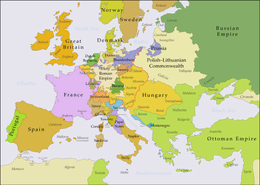
Bestuzhev
Elizabeth abolished the cabinet council system that had been used under Anna, and reconstituted the Senate as it had been under Peter the Great with the chiefs of the departments of state (none of them Germans) attending. Her first task after this was to address the war with Sweden. On 23 January 1743 direct negotiations between the two powers were opened at Åbo (Turku). In the Treaty of Åbo, on 7 August 1743 (O.S.), Sweden ceded to Russia all of southern Finland east of the Kymmene River, which became the boundary between the two states. The treaty also gave Russia the fortresses of Villmanstrand and Fredrikshamn.[23]
This triumphant result can be credited to the diplomatic ability of the new vice chancellor, Aleksey Bestuzhev-Ryumin. His policies would have been impossible without her support.[24] Elizabeth had wisely placed Bestuzhev at the head of foreign affairs immediately after her accession. He represented the anti-Franco-Prussian portion of her council, and his object was to bring about an Anglo-Austro-Russian alliance which, at that time, was undoubtedly Russia's proper system. Hence the bogus Lopukhina Conspiracy and other attempts of Frederick the Great and Louis XV to get rid of Bestuzhev failed, but it put the Russian court into the centre of a tangle of intrigue during the earlier years of Elizabeth's reign).[23]
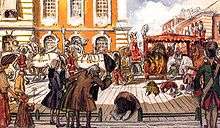
Ultimately, the minister's strong support from Elizabeth prevailed.[24] His faultless diplomacy, and an auxiliary Russian corps of 30,000 men sent to the Rhine, greatly accelerated the peace negotiations leading to the Treaty of Aix-la-Chapelle (18 October 1748). By sheer tenacity of purpose, Bestuzhev had extricated his country from the Swedish imbroglio; reconciled his imperial mistress with the courts of Vienna and London; enabled Russia to assert herself effectually in Poland, Ottoman Empire and Sweden; and isolated the King of Prussia by forcing him into hostile alliances. All this would have been impossible without the steady support of Elizabeth who trusted him completely in spite of the Chancellor's many enemies, most of whom were her personal friends.[23]
However, on 14 February 1758, Bestuzhev was removed from office. The future Catherine II recorded, "He was relieved of all his decorations and rank, without a soul being able to reveal for what crimes or transgressions the first gentleman of the Empire was so despoiled, and sent back to his house as a prisoner." No specific crime was ever pinned on Bestuzhev. Instead, it was inferred that he had attempted to sow discord between the Empress and her heir and his consort. Enemies of pro-Austrian Bestuzhev were his rivals; the Shuvalov family, Vice-Chancellor Mikhail Vorontsov, and the French ambassador.[25]
Seven-Years War
The great event of Elizabeth's later years was the Seven Years' War. Elizabeth regarded the Convention of Westminster (16 January 1756) in which Great Britain and Prussia agreed to unite their forces to oppose the entry of or the passage through Germany of troops of every foreign power, as utterly subversive of the previous conventions between Great Britain and Russia. Elizabeth sided against Prussia over a personal dislike of Frederick the Great.[19] She wanted him reduced within proper limits so that he might no longer be a danger to the empire. Elizabeth acceded to the Second Treaty of Versailles, thus entering into an alliance with France and Austria against Prussia. On 17 May 1757 the Russian army, 85,000 strong, advanced against Königsberg.[26]
.jpg)
The serious illness of the Empress, which began with a fainting-fit at Tsarskoe Selo (19 September 1757), the fall of Bestuzhev (21 February 1758) and the cabals and intrigues of the various foreign powers at Saint Petersburg, did not interfere with the progress of the war. The crushing defeat of Kunersdorf (12 August 1759)[27] at last brought Frederick to the verge of ruin. From that day, he despaired of success, but he was saved for the moment by the jealousies of the Russian and Austrian commanders, which ruined the military plans of the allies.[23]
From the end of 1759 to the end of 1761, the firmness of the Russian Empress was the one constraining political force that held together the heterogeneous, incessantly jarring elements of the anti-Prussian combination. From the Russian point of view, her greatness as a stateswoman consists in her steady appreciation of Russian interests, and her determination to promote them at all hazards. She insisted throughout that the King of Prussia must be rendered harmless to his neighbors for the future and that the only way to do so was to reduce him to the rank of a Prince-Elector.[23]
Frederick himself was quite aware of his danger. "I'm at the end of my resources," he wrote at the beginning of 1760. "The continuance of this war means for me utter ruin. Things may drag on perhaps till July, but then a catastrophe must come." On 21 May 1760, a fresh convention was signed between Russia and Austria, a secret clause of which, never communicated to the court of Versailles, guaranteed East Prussia to Russia as an indemnity for war expenses. The failure of the campaign of 1760, wielded by the inept Count Buturlin, induced the court of Versailles on the evening of 22 January 1761 to present to the court of Saint Petersburg a dispatch to the effect that the king of France, by reason of the condition of his dominions, absolutely desired peace. The Russian empress' reply was delivered to the two ambassadors on 12 February. It was inspired by the most uncompromising hostility towards the king of Prussia. Elizabeth would not consent to any pacific overtures until the original object of the league had been accomplished.[23]

Simultaneously, Elizabeth had conveyed to Louis XV a confidential letter in which she proposed the signature of a new treaty of alliance of a more comprehensive and explicit nature than the preceding treaties between the two powers without the knowledge of Austria. Elizabeth's object in the mysterious negotiation seems to have been to reconcile France and Great Britain, in return for which signal service France was to throw all her forces into the German war. This project, which lacked neither ability nor audacity, foundered upon Louis XV's invincible jealousy of the growth of Russian influence in Eastern Europe and his fear of offending the Porte. It was finally arranged by the allies that their envoys at Paris should fix the date for the assembling of a peace congress and that in the meantime, the war against Prussia should be vigorously prosecuted. In 1760 a Russian flying column briefly occupied Berlin. Russian victories placed Prussia in serious danger.[27]
The campaign of 1761 was almost as abortive as the campaign of 1760. Frederick acted on the defensive with consummate skill, and the capture of the Prussian fortress of Kolberg on Christmas Day 1761, by Rumyantsev, was the sole Russian success. Frederick, however, was now at the last gasp. On 6 January 1762, he wrote to Count Karl-Wilhelm Finck von Finckenstein, "We ought now to think of preserving for my nephew, by way of negotiation, whatever fragments of my territory we can save from the avidity of my enemies", which meant, if words mean anything, that he was resolved to seek a soldier's death on the first opportunity. A fortnight later, he wrote to Prince Ferdinand of Brunswick, "The sky begins to clear. Courage, my dear fellow. I have received the news of a great event." The Miracle of the House of Brandenburg that snatched him from destruction was the death of the Russian empress, on 5 January 1762 (N.S.).[27]
Selection of heir
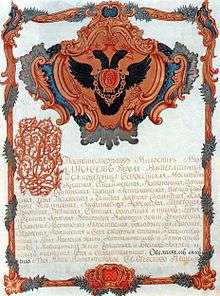
As an unmarried and childless empress, it was imperative for Elizabeth to find a legitimate heir to secure the Romanov dynasty. She chose her nephew, Peter of Holstein-Gottorp. Elizabeth was only too aware that the deposed Ivan VI, whom she had imprisoned in the Schlusselburg Fortress and placed in solitary confinement, was a threat to her throne. Elizabeth feared a coup in his favour and set about destroying all papers, coins or anything else depicting or mentioning Ivan.[28] Elizabeth had issued an order that if any attempt were made for him to escape, he was to be eliminated. Catherine II upheld the order and when an attempt was made, he was killed and secretly buried within the fortress.[28]
The young Peter had lost his mother, Elizabeth's sister Anna, at three months old and his father at the age of eleven. Elizabeth invited her young nephew to Saint Petersburg, where he was received into the Orthodox Church and proclaimed heir on 7 November 1742.[29] Elizabeth immediately gave him Russian tutors. Keen to see the dynasty secured, Elizabeth settled on Princess Sophie of Anhalt-Zerbst as a bride for her nephew. Incidentally, Sophie's mother, Joanna Elisabeth of Holstein-Gottorp, was a sister of Elizabeth's own fiancé who had died before the wedding. On her conversion to the Russian Orthodox Church Sophie was given the name Catherine in memory of Elizabeth's mother. The marriage took place on 21 August 1745. Nine years later a son, the future Paul I, was finally born on 20 September 1754.[30]
There is considerable speculation as to the actual paternity of Paul I. It is suggested that he was not Peter's son at all but that his mother had engaged in an affair, to which Elizabeth had consented, with a young officer, Sergei Vasilievich Saltykov, who would have been Paul's real father.[31] In any case, Peter never gave any indication that he believed Paul to have been fathered by anyone but himself. He also did not take any interest in parenthood.[32] Elizabeth most certainly took an active interest. She removed the young Paul and acted as if she were his mother instead of Catherine.[32] The Empress had ordered the midwife to take the baby and to follow her. Catherine was not to see her child for another month and then only briefly for the churching ceremony.[33] Six months later, Elizabeth let Catherine see the child again. The child had in effect become a ward of the state and, in a larger sense, the property of the state, to be brought up by Elizabeth as she believed he should be: as a true heir and great-grandson of her father, Peter the Great.[33]
Death
In the late 1750s Elizabeth's health started to decline. She began to suffer a series of dizzy spells and refused to take the prescribed medicines. She forbade the word "death" in her presence.[34] Elizabeth suffered a stroke on Christmas Eve 1761. Knowing that she was dying, Elizabeth used her last remaining strength to make her confession, to recite with her confessor the prayer for the dying and to say farewell to those few people who wished to be with her, including Peter and Catherine and Counts Alexei and Kirill Razumovsky. The Empress died the next day, 25 December 1761 (O.S.).[35] For her lying in state she was dressed in a shimmering silver dress; she was beautiful in death as she had been in life. She was buried in the Peter and Paul Cathedral in Saint Petersburg on 3 February 1762 (O.S.) after six weeks lying in state.[34]
The Court of the Empress


Under the reign of Elizabeth, the Russian court was one of the most splendid in all Europe.[19] Foreigners were amazed at the sheer luxury of the sumptuous balls and masquerades. The Russian court had steadily increased in importance throughout the 18th century and came to hold more cultural significance than many of its Western counterparts due its inclusive nature; any "well to do inhabitants" were welcome at Court. The Court, like most Imperial Courts, was considered a reflection of the ruler at its center and Elizabeth was said to be "the laziest, most extravagant and most amorous of sovereigns."[36] Elizabeth was intelligent but lacked the discipline and early education necessary to flourish as an intellectual; she found the reading of secular literature to be "injurious to health."[37] She was kind and warm-hearted for the emotion's sake alone, once going so far as to offer to finance the reconstruction of Lisbon after the 1755 earthquake destroyed the Portuguese city despite having and wanting no diplomatic relationship with the nation.[38] She hated bloodshed and conflict and went to great lengths to alter the Russian system of punishment, even outlawing capital punishment.[39] Even in court this peacemaker spirit made itself evident. According to historian Robert Nisbet Bain, it was one of Elizabeth's "chief glories that, so far as she was able, she put a stop to that mischievous contention of rival ambitions at Court, which had disgraced the reigns of Peter II, Anne and Ivan VI, and enabled foreign powers to freely interfere in the domestic affairs of Russia."[40] She was also deeply religious, passing several pieces of legislation that undid much of the work her father had done to limit the power of the church.[41] Yet of all her various characteristics manifested in the structure of Court life the most evident were her extravagance, her vanity, and her gaiety and playful nature.
Elizabeth's notorious extravagance came to define her court in many respects. The Empress created a world in which aesthetics reigned supreme; courtiers competed to see who could look best, second only to Her Majesty. As historian Mikhail Shcherbatov stated, her court was "arrayed in cloth of gold, her nobles satisfied with only the most luxurious garments, the most expensive foods, the rarest drinks, that largest number of servants and they applied this standard of lavishness to their dress as well."[42] Clothing soon became the chosen means in Court by which to display wealth and social standing. Elizabeth reportedly owned 15,000 dresses, several thousand pairs of shoes, and a seemingly unlimited number of stockings.[19] She was known to never wear a dress twice, and to change outfits anywhere from two to six times a day. Since the Empress did this, her courtiers did as well. To make sure no one wore a dress more than once to any ball or notably formal occasion, the Empress had her guards stamp each gown with special ink.[43] Men at court were known to wear diamond buttons, own jeweled snuff boxes, and adorn their servants in uniforms made of gold. It was also during her reign that a great number of silver and gold objects were produced, the most the country had seen thus far in its history.[44]
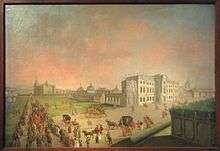
Elizabeth's extravagance was also clearly displayed in Court menus. It was not unheard of for her to order over a thousand bottles of French champagnes and wines at any given time to be served at one event and present pineapple at all her receptions, despite the difficulty of procuring the fruit in such quantities.[45] However, Elizabeth's incredible extravagance and adoration of exotic goods ended up greatly benefiting the country's infrastructure. Needing goods shipped from all over the world, Russia's roads were modernized to help fulfill the Empress' many desires.[46]
Elizabeth's vanity and the attention paid to her personal appearance also had indelible ramifications on Court life. Elizabeth, as a young woman, had been incredibly attractive; in turn, she desired to be the most attractive among any company at all times. To ensure this, Elizabeth passed various decrees outlining acceptable appearance. These edicts included a law against wearing the same hairstyle, dress, or accessory as the Empress. One woman, Natalya Lopukhina, accidentally wore the same item as the Empress and was lashed across the face for it.[43] Another law required French fabric salesmen to sell to Elizabeth first; those who disregarded this law were arrested.[43] One famous story exemplifying the Empress' vanity is that once Elizabeth got a bit of powder in her hair and was unable to remove it. She had to cut her hair to rid herself of the splotch; she made all of the Court ladies cut patches out of their hair, too, which they did "with tears in their eyes."[47] This aggressive vanity became a tenet of Elizabeth's Court throughout the entirety of her reign, particularly as she grew older. According to the historian Tamara Talbot Rice, "Later in life her outbursts of anger were directed either against people who were thought to have endangered Russia's security or against women whose beauty rivaled her own."[46]
Arts and culture at the Court
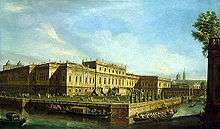

Despite Elizabeth's volatile, often violent reactions in regards to her appearance, the Empress was ebullient in most other matters, particularly when it came to Court entertainment. Elizabeth was renowned throughout and beyond Russia for the balls she held and her fierce commitment to the arts, particularly music, theatre, and architecture. It is reported that Elizabeth threw two balls a week. One would be a large event with an average of 800 guests in attendance, most of whom were the nation's leading merchants, members of the lower nobility, and guards stationed in and around the city of the event. The other ball was a much smaller affair reserved for Elizabeth's closest friends as well as members of the highest echelons of nobility.[48] These smaller gatherings began as masked balls but evolved into the famous Metamorphoses balls by 1744.[49] At these Metamorphoses balls, guests were expected to dress as the opposite sex, with Elizabeth often dressing up as Cossack or carpenter in honor of her father.[49] The costumes not permitted at the event were those of pilgrims and harlequins, which the Empress considered profane and indecent respectively.[50] Most members of court thoroughly disliked these balls since most looked ridiculous but Elizabeth adored them. As Catherine the Great's advisor Potemkin posited, this adoration was due to the fact that she was "the only woman who looked truly fine, and completely a man… As she was tall and powerful, male attire suited her."[51] Kazimierz Waliszewski also noted that Elizabeth had beautiful legs (or at least she was told so), and loved to wear male attire because of the tight trousers.[52] Though the balls were by far her most personally beloved and lavish events, Elizabeth often threw children's birthday parties and wedding receptions for those affiliated with her Court, going so far as to provide dowries for each of her ladies-in-waiting.[53]
The other court pastimes most enjoyed by Elizabeth and therefore most revered in Court were theatre, music, and architecture. The Empress had a longstanding love of theatre and had a stage erected in the palace to enjoy the countless performances she sanctioned. Though countless domestic and foreign works were shown, the French plays quickly became the most popular, often being performed twice a week. In tandem with Elizabeth's love of theatre, music came to be of high importance in Court.[54] Many attribute its popularity to Elizabeth's relationship with Alexei Razumovsky, a Ukrainian Cossack and the supposed husband of the Empress, who reportedly relished music. Regardless of the reasoning behind its introduction, Elizabeth transformed "her court into the country's leading musical center."[54] She would spare no expense in its regard, importing leading musical talents from Germany, France, and Italy.[55] As to the Empress' love of architecture, she financed many construction projects during her reign. Her most famous creations were the Winter Palace, which she commissioned and oversaw the construction of but died before its completion, and the Smolny Convent. The Convent, built when Elizabeth considered becoming a nun, was one of the many religious buildings erected at her behest, using the nation's funds (rather than those of the church). According to Robert Nisbet Bain, "No other Russian sovereign ever erected so many churches."[56]
Elizabeth in popular culture
- Empress Elizabeth has appeared numerous times in dramatizations of Catherine II's life. The 1934 film Catherine the Great (based on the play The Czarina by Lajos Bíró and Melchior Lengyel) starred Flora Robson as Elizabeth. 1934 also saw the release of The Scarlet Empress, another filmed version of Catherine the Great's story, this time with Louise Dresser in the role of Elizabeth. She was played by Olga Chekhova in the 1936 German film The Empress's Favourite. The 1991 TV miniseries Young Catherine features Vanessa Redgrave in the role. Jeanne Moreau portrayed Elizabeth in the 1995 television movie Catherine the Great. She is also a major character in several episodes of the Japanese animated series, Le Chevalier D'Eon.
- Elizabeth appears as a character in the historical-fiction novel "The Winter Palace" by Eva Stachniak and as a character in the novel "The Mirrored World" by Debra Dean.
- Elizabeth appears as a character in the historical novel "A Princess at the Court of Russia" by Eva Martens.
- In Catherine, a 2014 Russia-1 television mini-series mainly focused on the future Empress Catherine the Great, Empress Elizabeth is played by Yuliya Aug.
See also
- Tsars of Russia family tree
References
- Antonov 2006, p. 105.
- Antonov 2006, p. 104.
- Coughlan 1974, p. 46.
- Coughlan 1974, p. 50.
- Coughlan 1974, p. 23.
- Bain 1911, p. 283.
- Cowles 1971, p. 66.
- Cowles 1971, pp. 66–67.
- Coughlan 1974, p. 58.
- Coughlan 1974, p. 59.
- Cowles 1971, p. 67.
- Coughlan 1974, p. 52.
- Bain 1911, pp. 283–284.
- Cowles 1971, pp. 67–68.
- Lindsay, J. O. (1957). The New Cambridge Modern History: Volume 7, The Old Regime, 1713–1763. Cambridge University Press. p. 332. ISBN 9781139055833.
- Sebag Montefiore 2016, p. 269.
- Sebag Montefiore 2016, p. 268.
- Antonov 2006, p. 106.
- Antonov 2006, p. 107.
- Hoetzsch 1966, p. 83.
- Forsyth, James (1992), A history of the peoples of Siberia: Russia's North Asian Colong 1581-1990, Cambridge University Press, p. 146
- Landers, Brian (2010). "To the Little Bighorn and Anadyrsk". Empires Apart: A History of American and Russian Imperialism. New York, NY: Pegasus Books. ISBN 9781605981062.
- Bain 1911, p. 284.
- Coughlan 1974, p. 57.
- Rounding 2006, pp. 118–119.
- Hoetzsch 1966.
- Hoetzsch 1966, p. 93.
- Antonov 2006, p. 103.
- Antonov 2006, p. 110.
- Antonov 2006, p. 119.
- Coughlan 1974, p. 108.
- Coughlan 1974, p. 111.
- Coughlan 1974, p. 112.
- Antonov 2006, p. 109.
- Sebag Montefiore 2016, p. 193.
- Talbot Rice 1970, p. 132.
- Bain 1899, p. 137.
- Talbot Rice 1970, p. 137.
- Talbot Rice 1970, p. 150.
- Bain 1899, p. 142.
- Talbot Rice 1970, p. 149.
- "The Iron-Fisted Fashionista" Russian Life Nov.-Dec. 2009 by Lev Berdnikov, pg. 54
- 'The Iron-Fisted Fashionista' Russian Life Nov.- Dec. 2009 by Lev Berdnikov, pg. 59
- Talbot Rice 1970, p. 164.
- Talbot Rice 1970, p. 134.
- Talbot Rice 1970, p. 148.
- Sebag Montefiore 2001, p. 24.
- Talbot Rice 1970, p. 135.
- Talbot Rice 1970, p. 136.
- Bain 1899, p. 154.
- Sebag Montefiore 2001, p. 26.
- Kazimierz Waliszewski "La Dernière Des Romanov, Élisabeth Ire, Impératrice De Russie, 1741–1762". Plon-Nourrit et cie, 1902
- Talbot Rice 1970, p. 138.
- Talbot Rice 1970, p. 160.
- Bain 1899, p. 151.
- Bain 1899, p. 138.
Works cited
| Wikimedia Commons has media related to Elizabeth of Russia. |
| Wikisource has the text of the 1905 New International Encyclopedia article Elizabeth Petrovna. |
- Antonov, Boris (2006). Russian Tsars. Saint Petersburg: Ivan Fiorodov Art Publishers. ISBN 5-93893-109-6.CS1 maint: ref=harv (link)
- Bain, Robert Nisbet (1899). The Daughter of Peter the Great: A History of Russian Diplomacy and of the Russian Court Under the Empress Elizabeth Petrovna, 1741–1762. Westminster.CS1 maint: ref=harv (link)
- Cowles, Virginia (1971). The Romanovs. London: William Collins.CS1 maint: ref=harv (link)
- Coughlan, Robert (1974). Jay Gold (ed.). Elizabeth and Catherine: Empresses of All the Russias. London: Millington Ltd. ISBN 0-86000-002-8.CS1 maint: ref=harv (link)
- Hoetzsch, Otto (1966). The Evolution of Russia. trans. Rhys Evans. London: Thames and Hudson.CS1 maint: ref=harv (link)
- Rounding, Virginia (2006). Catherine the Great: Love, Sex and Power. London: Hutchinson. ISBN 0-09-179992-9.CS1 maint: ref=harv (link)
- Sebag Montefiore, Simon (2001). Prince of Princes: The Life of Potemkin. New York: Thomas Dunne Books. ISBN 9780312278151.CS1 maint: ref=harv (link)
- Sebag Montefiore, Simon (2016). The Romanovs: 1613–1918. Knopf Doubleday Publishing Group. ISBN 978-0307280510.CS1 maint: ref=harv (link)
- Talbot Rice, Tamara (1970). Elizabeth, Empress of Russia. Praeger. ISBN 978-0297001096.CS1 maint: ref=harv (link)

External links
- Romanovs. The fourth film. Anna Ioannovna; Elizabeth Petrovna on YouTube – Historical reconstruction "The Romanovs". StarMedia. Babich-Design (Russia, 2013)
Elizabeth of Russia House of Romanov Born: 29 December 1709 Died: 5 January 1762 | ||
| Regnal titles | ||
|---|---|---|
| Preceded by Ivan VI |
Empress of Russia 6 December 1741 – 5 January 1762 |
Succeeded by Peter III |
.svg.png)
.svg.png)
